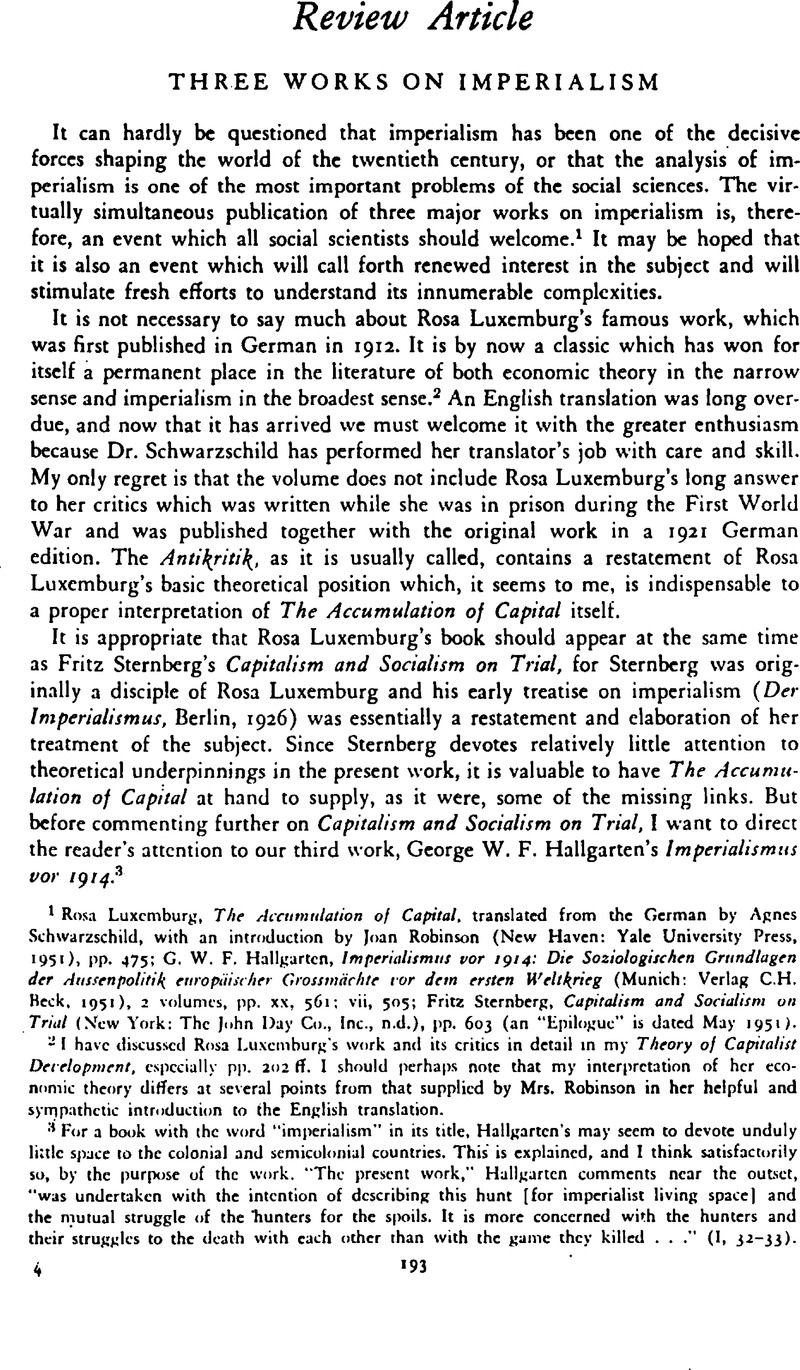Article contents
Three Works on Imperialism
Published online by Cambridge University Press: 03 February 2011
Abstract

- Type
- Review Article
- Information
- Copyright
- Copyright © The Economic History Association 1953
References
1 Luxemburg, Rosa, The Accumulation of Capital, translated from the German by Schwarzschild, Agnes, with an introduction by Joan Robinson (New Haven: Yale University Press, 1951), PP. 475Google Scholar; Hallgarten, G. W. F., Imperialismus vor 1914: Die Soziologischen Grundlagen der Aussenpolitik europäischer Grossmächte ror dem ersten Weltkrieg (Munich: Verlag C.H. Beck, 1951), 2 volumes, pp. xx, 561Google Scholar; vii, 505; Fritz Sternberg, Capitalism and Socialism on Trial (New York: The John Day Co., Inc., n.d.), pp. 603 (an “Epilogue” is dated May 1951).
2 I have discussed Rosa Luxemburg's work and its critics in detail in my Theory of Capitalist Development, especially pp. 202 ff. I should perhaps note that my interpretation of her economic theory differs at several points from that supplied by Mrs. Robinson in her helpful and sympathetic introduction to the English translation.
3 For a book with the word “imperialism” in its title, Hallgarten's may seem to devote unduly little space to the colonial and semicolonial countries. This is explained, and I think satisfactorily so, by the purpose of the work. “The present work,” Hallgarten comments near the outset, “was undertaken with the intention of describing this hunt [for imperialist living space] and the mutual struggle of the hunters for the spoils. It is more concerned with the hunters and their struggles to the death with each other than with the game they killed …” (I, 32–33).
4 Kehr's work, published in a number of papers in the theoretical organ of the Social Democratic Party, Die Gesellschaft, of which Hilferding was then editor, and in his one book-leagth study, Schlachtflottenbau und Parteipolitik, 1894–1901 (Berlin, 1930)Google Scholar, is of fundamental importance to an understanding of German imperialism. Hallgarten's method is similar to Kehr's, and both show a strong affinity to Hilferding's Finanzkapital (1910), especially to the last section (“Zur Wirtschaftspolitik des Finanzkapitals”).
5 The nonspecialist reader, incidentally, will want to study Hallgarten with a shelf of good reference works at hand. These should include at a minimum an encyclopedia, an atlas, and sonic standard historical treatises on the period 1871–1914. For all but the last twelve years of the period, the most useful works are Langer's European Alliances and Alignments and The Diphmary of Imperialism, 1890–1902, to which Hallgarten pays generous tribute. To read Langer in conjunction with Hallgarten does more than provide necessary factual background: it also shows how much more deeply one can penetrate into the “causes of things” by Hallgarten's methods than by those of the traditional diplomatic historian.
6 Aside from useful notes, printed in italics and dealing principally with literature which appeared after 1933, the published version is substantially identical with the original manuscript. Mr. Hallgarten was wise to follow this course. The work gains in stature whin viewed in the light of subsequent research more than it could have benefited by attempting to incorporate the detailed results of that research.
- 1
- Cited by


